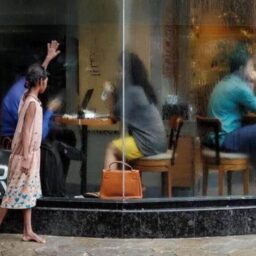FACTS
The Allahabad High Court’s judgment granting bail to a gangster apprehended under Section 3 (1) of the Uttar Pradesh Gangster and Anti-Social Activities (Prevention) Act, 1986 was overturned by a three-judge panel led by former CJI SA Bobde, AS Bopanna, and V. Ramasubramanian, JJ. In collusion with others, the accused, a contract killer and sniper, murdered Rajnarain Singh. In reality, the accused has been charged with major crimes such as murder, attempted murder, and criminal conspiracy in fifteen previous cases. For this situation, the spouse of the expired casualty pursued against the request for the High Court in allowing bail to the blamed who was captured under charges for Section 120B, Section 302, Sections 3 and Section 25 of the act[1]. It was asserted by the appealing party that the blamed is an agreement executioner and has somewhere around 15 arguments enrolled against him, including murder, endeavour to murder, and criminal trick. The appealing party has additionally contended that the learned High Court has not thought about the past criminal history of the charged before absolving him and the compromising of the observers which have constrained the Sessions Court to concede assurance to the witness.
The Supreme Court was informed that the Allahabad High Court conceded abandon somewhat permissive conditions, including the execution of an individual attach as per the general inclination of the prison specialists and the arrangement of guarantees within a month of his delivery. “By coordinating his criminal operations, the High Court has simply overlooked the accused’s history and the ability to repeat his acts.” The murdered victim’s widow also claimed that the accused’s behavior during the trial was one of non-cooperation, claiming that he did not cross-examine witnesses first, then prayed for their recall, and then threatened witnesses with his henchmen. Indeed, the accused’s actions prompted the Sessions court to order the police to provide security in the courtroom and for the witnesses during the trial. The appellant also made a compelling case that routinely granting bail to criminals has harmed the law and order situation in the past. The Court was reminded of the case of Vikas Dubey, who was charged with 64 criminal charges, including murders, dacoity, criminal intimidation, extortion, and violations of the UP-Gangster Act, among others, but was released on bail. Finally, when a police team tried to seize him in a case, eight police officers were allegedly slain, with several others seriously injured. Considering the applicable realities as a whole, the Court inferred that the high court ignored numerous angles, like the expected danger to witnesses, requiring the preliminary court to grant observer insurance.
ISSUE
Whether the courts need to perceive the potential risk to the life and freedom of victims/witnesses if such accused is discharged on bail?
CONTENTION
According to the prosecution, the accused and others run an organized crime group in Azamgarh that allegedly commits crimes that are punishable by death under the Indian Penal Code’s Chapters 16, 17 and 22[2]. The gang’s sole objective is to gain physical and financial advantage. Gains are made by committing numerous significant offenses. This group is also said to inspire immense fear and terror. It creates fear in the area where it functions, making it impossible for it to operate. preventing people from coming forward and filing police reports oppose its operations, including even deposing in court cases concerning it is communicated by the prosecutor, who is the life partner of the terminated setback that the director of the charged during the fundamental of the case in Case No. 511 of 2016 has been one of nonacoordinate effort, by not talking the spectators in any case, then, appealing to God for their survey and subsequently compromising eyewitnesses through his partners. Without a question, the lead of the charge affected the Sessions court to coordinate the police to grant security within the court amid the elemental and provide security to the onlookers.[3]
The appellant further claims that granting bail to criminals regularly has harmed the peace and order situation in the past. The appellant uses the example of a person who was charged with 64 criminal offenses, including murders, dacoity, criminal intimidation, extortion, and violations of the UP-Gangster Act but was released on bond. Finally, when a police team tried to seize him in a case, eight police officers were allegedly slain, with several others seriously injured. As a result, the appellant maintains that courts must exercise extraordinary caution when releasing history sheeters accused of heinous crimes such as murder, rape, or other forms of bodily harm.
RATIONALE
This can be a criminal charm reported against the demand for the Allahabad High Court giving bail to the denounced who has been captured concerning the offense culpable under Area 3 (1) of the U.P. Criminal and Anti-Social Activities (Avoidance) Act, 1986. In Neeru Yadav vs. the State of U.P.[4] this Court held that where a case was made that the blamed was a set of experiences sheeter, the High Courts needed to inspect everything about not discretionarily record that the denounced was permitted to abandon impartial grounds. This Jury remarked in Ash Mohammad vs. Shiv Raj Singh[5] that when civilians are afraid to live peacefully and terrible crimes block the creation of a well-ordered society, the courts play a further vital function, and the obligation is severe. It underlined the importance of doing a thorough investigation into the accused’s history of violence. It was ruled in Prasanta Kumar Sarkar vs. Ashis Chatterjee[6] and Others 3 that this Jury would not generally intervene with a High Court’s ruling issuing or denying bail to an accused. Nonetheless, it was equally important for the High Court to use its discretion wisely, prudently, and rigorously following the balance established by a series of this Court’s rulings. The taking after viewpoints are considered within the choice:
- whether there was a prima facie or sensible premise to believe that the blamed had committed a criminal act;
- the essence and gravity of the inquiries
- the enormity of the authorize inside the occasion of a prosecution
- the risk of the suspect defaulting or escaping if released on bail; and
- the accused’s personality, conduct, circumstances, situation, and status;
- the plausibility of the occurrence being rehashed;
- the legitimate fear of the testimony having manipulated; and
- the risk of equity becoming obstructed by the issuance of bail.
The Supreme Court, after examining all of the aforementioned facts, overturned the High Court’s ruling granting bail to the accused. That alone would have not prompted us to issue the ruling we recommend, but it is clear that the respondent has a history that contradicts the High Court’s decision to award him release.
DEFECTS IN THE LAW
In this matter, we believe that the high court disregarded several factors, including the potential threat to evidence, prompting the trial court to provide safety. It goes without saying that in circumstances like this, judges mustn’t release an accused on bail based solely on the participants in front of them and the incident in question. Courts must evaluate the implications that releasing such individuals on the bond may have on the informants who have still to be examined and the innocent members of the victim’s family who may become the next target.[7]
INFERENCE
The Allahabad High Court allowed safeguard to the respondents in this criminal case based on the supplication made within the criminal complaint. extraordinarily lenient terms, such as the execution of an individual bond based on the jail authorities’ general propensity and the provision of guarantees within a month of his surrender. The charged predecessors and the opportunity to rehash his demonstrations by sorting up his crook exercises have been largely neglected by the High Court.
CONCLUSION
We do not intend to pronounce on the authenticity of the allegations, nor do we intend to use them to determine the respondent’s guilt. The Supreme Court has emphasized that while issuing bail to an alleged offender, tribunals must examine the effect on witnesses or victims in a criminal case. As a result, the Supreme Court overturned an Allahabad High Court ruling granting bail to a suspect. I agree with the Judgement given by the honourable Supreme Court regarding this case.
Author(s) Name: Guntupalli Srilatha (Dr. B.R Ambedkar College of Law, Andhra University)
References:
[1] arms act, 1959, act no. 54 of 1959
[2] Indian penal code ,1860 ,chapters 16,17 and 22
[3] Sudha Singh v the state of Uttar Pradesh & anr., para 4
[4] Neeru Yadav vs. the State of U.P (2014) 16 SCC 508
[5] Ash Mohammad vs. Shiv Raj Singh (2012) 9 SCC 446
[6] Prasanta Kumar Sarkar vs. Ashis Chatterjee (2010) 14 SCC 496
[7] Supra note 3, para 8
















